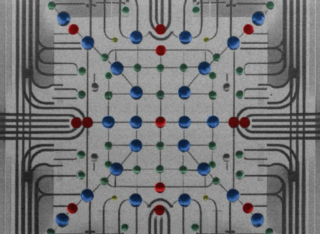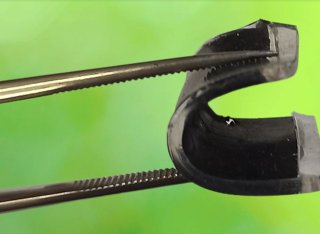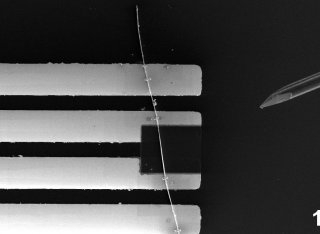
Dr Mateus Gallucci Masteghin
Academic and research departments
Faculty of Engineering and Physical Sciences, Advanced Technology Institute.News
In the media
Publications
This work has focused on the electrical and microstructural properties of Nb2O5-doped SnO2-MnO2 ceramics. The pellets were prepared by solid-state reaction method according to the system (99.5-x) SnO2 - 0.5 MnO2 - x Nb2O5, on the following molar ratio x = 0.05; 0.10; 0.15; 0.20 and 0.25. Scanning electron microscopy and electrical measurements (ac and dc) were used to study the materials properties. The results showed that the increase of Nb2O5 content in the SnO2-MnO2 matrix has led to an increase in the varistor properties. A detailed study of the electrical properties of materials was conducted using impedance spectroscopy and the results indicated that Nb2O5 has a tendency to form an electron trapping level near the conduction band. In order to explain these findings, a parallel equivalent circuit model was used to simulate the values of the grain boundary resistance. A close relationship was found between the value of the nonlinear coefficient and the grain boundary resistance for the studied varistors, where both values increased with increasing the amount of Nb2O5, which is important for practical applications.
Semiconducting metal oxides have many practical applications, including varistors. Varistors based on SnO2 exhibit both high nonlinear coefficients and high breakdown electric fields. In this work, we present a facile mean for controlling the breakdown electric field in the SnO2-CoO-Cr2O3-Nb2O5 varistor system by the introduction of 1D SnO2 nanobelts. The materials were prepared by a solid state reaction method with Nb2O5 doping levels at 0.10 and 0.20, mole percent. The materials were studied in detail by dual beam microscopy, direct current and impedance measurements. Exaggerated three-dimensional growth of the tin dioxide belts was observed, which was attributed to Ostwald ripening. The breakdown electric field was observed to decrease from 2510 V/cm to 2280 V/cm and from 1700 V/cm to 804 V/cm after nanobelt insertion, into the systems with 0.10 and 0.20, mole percent Nb2O5 respectively. A model for the observed results was proposed based on the percolation of electrons through the belts, decreasing the number of effective potential barriers at the grain boundaries. The simulations of the impedance data showed one order of magnitude decrease in the grain boundary resistance due to the nanobelt insertion for both studied systems.
This paper presents the results of a thorough study conducted on the action mechanism of one-dimensional single-crystalline SnO2 nanobelts in decreasing the breakdown electric field (Eb) in SnO2-based varistors. The proposed method has general validity in that our investigation was focused on the traditional varistor composition SnO2-CoO-Cr2O3-Nb2O5. To accomplish our study objective, two methods of decreasing Eb value were compared; one involving the increase in average grain size of the varistor through the sintering time and the other one related to the addition of nanobelts. The morphological results show that the method involving the increase in average grain size is limited by the formation of intragranular pores. Furthermore, despite contributing successfully towards decreasing the Eb value (which underwent a decline from 3990 V cm−1 to 1133 V cm−1 with an increase in sintering time from 1 h to 2 h), the reduction obtained by this method is found to be much lower compared to that obtained via the nanobelts insertion method (Eb = 270 V cm−1). Impedance spectroscopy results showed that the insertion of nanobelts caused a decline in the grain boundary resistance while surface potential measurements proved that this decline in resistance is attributed to the absence of potential barriers along the belts which leads to the formation of a lower resistance percolation path in the varistor.
SnO2-based varistors have been considered promising technological devices. However their practical application is usually stated as limited to high voltage circuits based on the high breakdown electric field exhibited by these ceramics. Recently, authors have shown that the insertion of one-dimensional (1D) SnO2 belts allows overcoming this limitation. In this work, we present a detailed study of the growth mechanism of the belts inside varistors using electron microscopy techniques. We were able to show that mass transport has an intrinsic dependence on the sintering time and requires similar crystalline structure between the belts and the matrix. Dual beam and high-resolution transmission electron microscopy techniques permitted determining that 3D growth of belts occurs by coalescence.
In this study, individual nanofabricated SnO micro-disks, previously shown to exhibit exceptional sensitivity to NOx, are investigated to further our understanding of gas sensing mechanisms. The SnO disks presenting different areas and thickness were isolated and electrically connected to metallic electrodes aided by a Dual Beam Microscope (SEM/FIB). While single micro-disk devices were found to exhibit short response and recovery times and low power consumption, large interconnected arrays of micro-disks exhibit much higher sensitivity and selectivity. The source of these differences is discussed based on the gas/solid interaction and transport mechanisms, which showed that thickness plays a major role during the gas sensing of single-devices. The calculated Debye length of the SnO disk in presence of NO2 is reported for the first time.
Micro-supercapacitors are an important class of energy storage devices for portable, self-powered and miniaturized electronics such as sensors, biomedical implants and RFID tags. To address the issue of limited energy density of micro-supercapacitors, pseudocapacitive transition-metal oxides have been used as electrodes at the cost of lower power capability due to their low electronic conductivity. In this work, high-energy-density and high-power-density nickel(II) oxide (NiO) micro-supercapacitors, fabricated through inkjet printing, are demonstrated. The nanoparticle-based thin film NiO electrodes showed up to 14 orders of magnitude higher electrical conductivity than single crystal NiO. The enhanced conductivity of the electrodes was reflected in the low relaxation time constant of just 30 ms, which is among the lowest achieved for any supercapacitor. A magnesium perchlorate-based aqueous electrolyte with extended operating voltage window was developed to enable the operation of the devices up to 1.5 V. The devices showed remarkable areal and volumetric specific capacitances of up to 155 mF cm−2 and 705 F cm−3 respectively, surpassing the state-of-the-art inkjet-printed supercapacitors but also a few of the best micro-supercapacitors known to date. This work provides a compelling platform to simplify the fabrication process of micro-supercapacitors, with focus on digital design, scalable manufacturing, and direct integration with printed electronics.
CNTs can have the ability to act as compliant small-scale springs or as shock resistance micro-contactors. This work investigates the performance of vertically-aligned CNTs (VA-CNTs) as micro-contactors in electromechanical testing applications for testing at wafer-level chip-scale-packaging (WLCSP) and wafer-level-packaging (WLP). Fabricated on ohmic substrates, 500-μm-tall CNT-metal composite contact structures are electromechanically characterized. The probe design and architecture are scalable, allowing for the assembly of thousands of probes in short manufacturing times, with easy pitch control. We discuss the effects of the metallization morphology and thickness on the compliance and electromechanical response of the metal-CNT composite contacts. Pd-metallized CNT contactors show up to 25 μm of compliance, with contact resistance as low as 460 mΩ (3.6 kΩ/μm) and network resistivity of 1.8 × 10−5 Ω cm, after 2500 touchdowns, with 50 μm of over-travel; they form reproducible and repeatable contacts, with less than 5% contact resistance degradation. Failure mechanisms are studied in-situ and after cyclic testing and show that, for top-cap-and-side metallized contacts, the CNT-metal shell provides stiffness to the probe structure in the elastic region, whilst reducing the contact resistance. The stable low resistance achieved, the high repeatability and endurance of the manufactured probes make CNT micro-contacts a viable candidate for WLP and WLCSP testing.
Recent interest in the fields of human motion monitoring, electronic skin, and human–machine interface technology demands strain sensors with high stretchability/compressibility (ε > 50%), high sensitivity (or gauge factor (GF > 100)), and long-lasting electromechanical compliance. However, current metal- and semiconductor-based strain sensors have very low (ε < 5%) stretchability or low sensitivity (GF < 2), typically sacrificing the stretchability for high sensitivity. Composite elastomer sensors are a solution where the challenge is to improve the sensitivity to GF > 100. We propose a simple, low-cost fabrication of mechanically compliant, physically robust metallic carbon nanotube (CNT)-polydimethylsiloxane (PDMS) strain sensors. The process allows the alignment of CNTs within the PDMS elastomer, permitting directional sensing. Aligning CNTs horizontally (HA-CNTs) on the substrate before embedding in the PDMS reduces the number of CNT junctions and introduces scale-like features on the CNT film perpendicular to the tensile strain direction, resulting in improved sensitivity compared to vertically-aligned CNT-(VA-CNT)-PDMS strain sensors under tension. The CNT alignment and the scale-like features modulate the electron conduction pathway, affecting the electrical sensitivity. Resulting GF values are 594 at 15% and 65 at 50% strains for HA-CNT-PDMS and 326 at 25% and 52 at 50% strains for VA-CNT-PDMS sensors. Under compression, VA-CNT-PDMS sensors show more sensitivity to small-scale deformation than HA-CNT-PDMS sensors due to the CNT orientation and the continuous morphology of the film, demonstrating that the sensing ability can be improved by aligning the CNTs in certain directions. Furthermore, mechanical robustness and electromechanical durability are tested for over 6000 cycles up to 50% tensile and compressive strains, with good frequency responses with negligible hysteresis. Finally, both types of sensors are shown to detect small-scale human motions, successfully distinguishing various human motions with reaction and recovery times of as low as 130 ms and 0.5 s, respectively.
Van der Waals (vdW) layered materials have been receiving a great deal of attention, especially after the scotch-tape experiment using graphite and the unique properties of graphene. Sn3O4, which also presents a layered structure, has been widely employed in a variety of technologies, but without further understanding of its bulk properties. For the first time, a modern Scotch-tape nanomanipulation experiment carried on a Dual Beam Microscope is combined with Density Functional Theory to investigate the Sn3O4 bulk properties. Theoretically, we have shown that the interaction energy between Sn3O4 layers are in the same order of graphene layers (21 meV Å−2), indicating its vdW interaction nature, whereas for SnO is slightly stronger (26 meV Å−2). Then, the Dual Beam Microscope nanomanipulation of the Sn3O4 nanobelts revealed the weak layer-layer interactions along their stacking direction (plane (0 1 0)). Comparatively, when probing SnO and SnO2 nanobelts, no exfoliation could be seen. The study of Sn3O4 electronic structure properties also presents the important role of the interfacial region to the valence and conduction band and, consequently, to the material band-gap. The outcome of this study will help improving some applications, e.g., knowing the total and local density of states can help understanding surface band bending following gases adsorption. To the best of our knowledge, this is the first study to show, combining experimental and theoretical techniques, Sn3O4 as a promising 2D material.
There is an increasing concern about NOx emission, and many studies have been carried out using metal oxide semiconductors (MOS) aiming its detection. Among the MOS, the SnO micro-disks present a high sensor response and a great selectivity toward NO2. Nevertheless, sensor signal, limit of detection (LOD), and recovery time are related to the experimental setup used to carry on the measurements. Thus, two different heating methods (self-heating and external heating) have been carried out to understand in what manner they change the sensor properties of the SnO micro-disks onto interdigitated electrodes. The external heating method presented higher sensor signal, best LOD, and lower recovery time, mainly due to the lack of a temperature gradient between the SnO disks and the chamber atmosphere. On the other hand, response time was shown to be the same regardless of the method. Briefly, the authors used thermodynamic equations to better understand the temperature effect on the gas-solid interactions occurring between SnO disks and NO2 species.
Materials Science is an interdisciplinary subject spanning physics and chemistry of matter, engineering applications, and industrial manufacturing processes. In such a context material science permeates varistor technology as well as the development of the chemistry of novel varistor components. Varistors are generally made of some semiconducting metal oxides that exhibit nonlinear current-voltage (I-V) behavior. Thus, material science is in the heart of practical applications and processes development involving varistors. These are incorporated into electrical networks to protect equipment against voltage surges. Here the focus is on the historical sequence of SnO2-based varistor system from the academic perspective of material science; briefly demonstrating how it competes with commercial systems such as ZnO. ZnO varistor has particular historical merits due to high nonlinear coefficient (~ 50), good energy absorption, low leakage current, and quick response to changes in voltage. Thus, it is widely used as fuses in electrical appliances and as surge arrester in the distribution and transmission power lines. Nonetheless, SnO2, due to its high electrical stability and less complex microstructure, has become viable to ZnO in particular applications. The challenges to SnO2 widely move into a large-scale commercial production is obviously not limited to physical or chemical superiority within the niches of the market but based on cost-effectiveness.
Carbon nanotubes (CNTs) can be used in many different applications. Field emission (FE) measurements were used together with Raman spectroscopy to show a correlation between the microstructure and field emission parameters. However, field emission characterization does not suffer from fluorescence noise present in Raman spectroscopy. In this study, Raman spectroscopy is used to characterize vertically aligned CNT forest samples based on their D/G band intensity ratio (ID/IG), and FE properties such as the threshold electric field, enhancement coefficient, and anode to CNT tip separation (ATS) at the outset of emission have been obtained. A relationship between ATS at first emission and the enhancement factor, and, subsequently, a relationship between ATS and the ID/IG are shown. Based on the findings, it is shown that a higher enhancement factor (3070) results when a lower ID/IG is present (0.45), with initial emissions at larger distances (47 lm). For the samples studied, the morphology of the CNT tips did not play an important role; therefore, the field enhancement factor (b) could be directly related to the carbon nanotube structural properties such as breaks in the lattice or amorphous carbon content. Thus, this work presents FE as a complementary tool to evaluate the quality of CNT samples, with the advantages of a larger probe size and an averaging over the whole nanotube length. Correspondingly, one can find the best field emitter CNT according to its ID/IG.
A high rate capability carbon encapsulated polyaniline (PANI) composite is fabricated by a novel electrodeposition method of polyaniline on a carbon nanotube (CNT) forest, grown on carbon paper. This is followed by coating of an amorphous carbon layer via hydrothermal carbonisation (HTC) of glucose, forming a three‐layer structure. We demonstrated that a slow scan rate, voltage restricted electrodeposition process can be used to produce a uniform PANI coating on individual CNTs throughout the network. The CNT base offers excellent electronic and structural connection for the PANI nanofibre network, while the coating of amorphous carbon reduces electrode resistance, promoting enhanced electrochemical performance and reinforced structural stability during charging and discharging.
The introduction of strain into semiconductors offers a well-known route to modify their band structure. Here, we show a single-step procedure for generating such strains smoothly and deterministically, over a very wide range, using a simple, easily available, highly scalable, ion implantation technique to control the degree of amorphization in and around single-crystal membranes. The amorphization controls the density of the material and thus the tension in the neighboring crystalline regions. We have demonstrated up to 3.1% biaxial tensile strain and 8.5% uniaxial strain in silicon, based on micro-Raman spectroscopy. This method achieves strain levels never previously reached in mesoscopic defect-free, crystalline silicon structures. The flexible, gently controllable, single-step process points toward very high mobility complementary metal-oxide-semiconductor devices and easy fabrication of direct-bandgap germanium for silicon-compatible optoelectronics.
The performance of all solar cells is dictated by charge recombination. A closer to ideal recombination dynamics results in improved performances, with fill factors approaching the limits based on Shockley–Queisser analysis. It is well known that for emerging solar materials such as perovskites, there are several challenges that need to be overcome to achieve high fill factors, particularly for large area lead–tin mixed perovskite solar cells. Here we demonstrate a strategy towards achieving fill factors above 80% through post-treatment of a lead–tin mixed perovskite absorber with guanidinium bromide for devices with an active area of 0.43 cm2. This bromide post-treatment results in a more favorable band alignment at the anode and cathode interfaces, enabling better bipolar extraction. The resulting devices demonstrate an exceptional fill factor of 83%, approaching the Shockley–Queisser limit, resulting in a power conversion efficiency of 14.4% for large area devices.
Typically used semiconducting metal oxides (SMOs) consist of several varying factors that affect gas sensor response, including film thickness, grain size, and notably the grain–grain junctions within the active device volume, which complicates the analysis and optimisation of sensor response. In comparison, devices containing a single nanostructured element do not present grain–grain junctions, and therefore present an excellent platform to comprehend the correlation between nanostructure surface stoichiometry and sensor response to the depletion layer (Debye length, LD) variation after the analyte gas adsorption/chemisorption. In this work, nanofabricated devices containing SnO2 and Sn3O4 individual nanobelts of different thicknesses were used to estimate their LD after NO2 exposure. In the presence of 40 ppm of NO2 at 150 °C, LD of 12 nm and 8 nm were obtained for SnO2 and Sn3O4, respectively. These values were associated to the sensor signals measured using multiple nanobelts onto interdigitated electrodes, outlining that the higher sensor signal of the Sn4+ surface (up to 708 for 100 ppm NO2 at 150°) in comparison with the Sn2+ (up to 185) can be explained based on a less depleted initial state and a lower surface electron affinity caused by the Lewis acid/base interactions with oxygen species from the baseline gas. To support the proposed mechanisms, we investigated the gas sensor response of SnO2 nanobelts with a higher quantity of oxygen vacancies and correlated the results to the SnO system.
Curved X-ray detectors have the potential to revolutionize diverse sectors due to benefits such as reduced image distortion and vignetting compared to their planar counterparts. While the use of inorganic semiconductors for curved detectors are restricted by their brittle nature, organic–inorganic hybrid semiconductors which incorporated bismuth oxide nanoparticles in an organic bulk heterojunction consisting of poly(3-hexylthiophene-2,5-diyl) (P3HT) and [6,6]-phenyl C71 butyric acid methyl ester (PC70BM) are considered to be more promising in this regard. However, the influence of the P3HT molecular weight on the mechanical stability of curved, thick X-ray detectors remains less well understood. Herein, high P3HT molecular weights (>40 kDa) are identified to allow increased intermolecular bonding and chain entanglements, resulting in X-ray detectors that can be curved to a radius as low as 1.3 mm with low deviation in X-ray response under 100 repeated bending cycles while maintaining an industry-standard dark current of <1 pA mm−2 and a sensitivity of ≈ 0.17 μC Gy−1 cm−2. This study identifies a crucial missing link in the development of curved detectors, namely the importance of the molecular weight of the polymer semiconductors used.
Organic‐inorganic hybrid semiconductors are an emerging class of materials for direct conversion X‐ray detection due to attractive characteristics such as high sensitivity and the potential to form conformal detectors. However, existing hybrid semiconductor X‐ray detectors display dark currents that are 1000–10 000× higher than industrially relevant values of 1–10 pA mm−2. Herein, ultra‐low dark currents of <10 pA mm−2, under electric fields as high as ≈4 V µm−1, for hybrid X‐ray detectors consisting of bismuth oxide nanoparticles (for enhanced X‐ray attenuation) incorporated into an organic bulk heterojunction consisting of p‐type Poly(3‐hexylthiophene‐2,5‐diyl) (P3HT) and n‐type [6,6]‐Phenyl C71 butyric acid methyl ester (PC70BM) are reported. Such ultra‐low dark currents are realized through the enrichment of the hole selective p‐type organic semiconductor near the anode contact. The resulting detectors demonstrate broadband X‐ray response including an exceptionally high sensitivity of ≈1.5 mC Gy−1 cm−2 and <6% variation in angular dependence response under 6 MV hard X‐rays. The above characteristics in combination with excellent dose linearity, dose rate linearity, and reproducibility over a broad energy range enable these detectors to be developed for medical and industrial applications.
The fabrication of a flexible supercapacitor with state-of-the-art performance is described, based on a facile and low-cost fabrication method that encompasses aligned carbon nanotube arrays (ACNTA)-polyaniline/polydimethylsiloxane electrodes (ACNTA-PANI/PDMS). The ACNTA were partially embedded in PDMS to ensure excellent adhesion and integration whilst PANI was electrodeposited on its surface to improve energy storage properties. The supercapacitor structure and morphology were investigated by Raman spectroscopy and scanning electron microscopy (SEM), respectively. The energy storage properties of the electrodes were evaluated in two and three-electrode configurations. The maximum value of specific capacitance was 408 mF cm−2 (265 F g−1) at 1 mA cm−2, and a high energy density of 20 μW h cm−2 (25.5 W h kg−1) was achieved at a power density of 100 μW cm−2 (126.6 W kg−1) for a symmetric two-electrode device. The device showed a good capacitance retention of 76% after 5000 cycles and was able to maintain 80% of its electrochemical properties while being measured at different bending angles, demonstrating excellent mechanical agility performance under extreme conditions and some of the highest carbon-based energy storage properties.
The material and electrical properties of silicon dioxide derived insulators formed with a focused electron beam in the presence of a TEOS or TMCTS precursor are presented. Raman and energy dispersive X-ray spectroscopy were used to analyse the chemical structure and composition of the deposited dielectric. It was found that the TEOS precursor induced a purer dielectric with a reduced carbon percentage (∼3%) which was independent of the electron beam energy. An investigation with TMCTS showed the importance of using an additional water vapour supply as an in-situ oxidising co-reactant, suppressing the deposited carbon content by up to a factor of six. Leakage current and voltage breakdown measurements were used to calculate the effective resistance and the dielectric strength of the insulator. The two precursors formed insulators with similar electrical properties with effective resistances on the order of GΩ for <100nm thick depositions and dielectric strengths of 7 MV cm−1, equivalent to those found in sputtered silicon dioxides, but allowing high-resolution maskless lithography.


